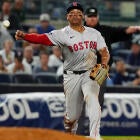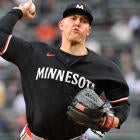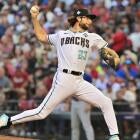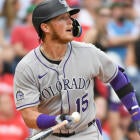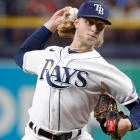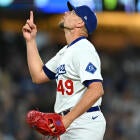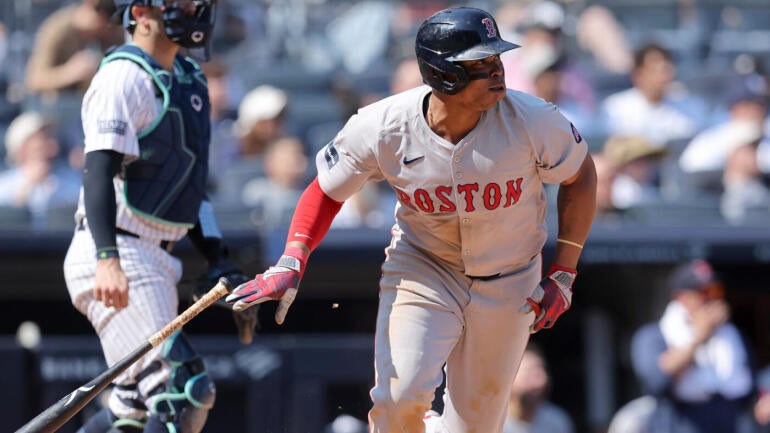
As a Fantasy Baseball player, the first week of the season might be the most exciting time of the year. All that time you spent prepping finally gets put into action after a long, cold offseason. You've got baseball to watch every day, and you're shooting up and down the standings in a way that just won't happen later in the season. It's exhilarating. It rocks.
But from the perspective of a Fantasy Baseball analyst, this is in some ways the most boring point in the season. I mean, sure it's exciting to watch baseball every night, and we've already had plenty of performances worth getting excited about this season, from Shane Baz to Hunter Goodman to Kris Bubic. That's the kind of stuff we're looking for in the early season.
But for the most part, the first few weeks of the season are about reminding yourself not to react to what you're seeing. We're just seven days into a six-month season, which just isn't enough time at all to change your opinion about most players . Anytime we get a question from a reader that's like, "Should I be worried about [Insert Early-Round Player Who is Struggling]?", the answer is almost always going to be,"No, it's April." Similarly, your "What's wrong with [Insert Star Player With Zero Hits So Far]?", questions will almost always be met with a resounding, "Probably nothing!"
This is a problem for content creators, because, "Probably nothing" is an awfully short column. So, with about one week now in the books, I'm going to try to identify some things that have happened so far that might matter moving forward. Maybe. All of the opinions you're about to read are going to pretty weakly held, but they could all matter.
Maybe
But first, one thing I'm skeptical about: "The Yankees torpedo bats are going to ruin baseball!!!!!!!"
One: The Yankees aren't the only team using the torpedo bats, Trevor. Second of all, they are extremely unlikely to be like "legal HGH" or require a ban. I'm open to the idea that this latest revolution in bat design might be more impactful than the axe handle or the hockey puck knob-handle, but I've also been doing this long enough to have seen plenty of other previous claims of One Weird Trick that was going to revolutionize baseball, and one thing always tends to be true: Water finds its level. Pitchers tried to combat the rise in home runs by focusing on sinkers; hitters started to train for that, so pitchers started throwing elevated four-seamers, which worked for a few years until that approach started to lose effectiveness. A few years ago, it was the sweeper that was going to change baseball; hitters started hitting the sweeper the more they saw it, and now everyone is trying to throw a splitter.
My point is, while the torpedo bats may make an impact for some hitters, the overall impact is likely to be marginal. The Yankees teed off on the Brewers pitchers in the first series of the season, but it's also worth remembering that all they managed off Freddy Peralta in the home opener was a couple of Yankee Stadium-aided solo shots. The bulk of the damage came off Nestor Cortes and Aaron Civale, who both have well below-average stuff for an MLB starter, plus a parade of mediocre relievers.
Let's not declare this a league-ruining development just yet. After all, Aaron Judge has still been the team's best hitter, and he isn't going near 'em – as he told reporters, "What I did the past couple of seasons speaks for itself." Other teams have players using these bats, and even Rhys Hoskins of the Brewers acknowledged he has an order in – that sound you heard was Trevor Megill muttering, "Et tu, Rhys?"
And it's important to remember that the people developing these bats are trying to sell a product. You should pretty much always be skeptical about claims being made by people trying to sell you products, and it's simply too early to say whether these bats are going to live up to the hype. And, of course, the fact that the Yankees were the first team using the bats to find success means the hype is going to be even more out of control.
The physics behind the bat are sound, of course, because extremely smart people are behind this. Putting more mass in the part of the bat where players are more likely to impact the ball should, in theory, create better results for those hitters. But the impact isn't going to be the same for every hitter, and for some, it might mess up their timing or ability to meet the ball where they want to.
But before we view the torpedo bats as a panacea that are going to turn everyone who picks them into a league-conquering slugger, why don't we wait for some actual data on these bats to come in? Jazz Chisholm having three homers in four games just isn't enough to say anything – especially when he's struck out 44% of the time in the early going with the new bats.
So, let's just all take a collective breath and try not to freak out. Try. Please.
Rafael Devers' bat speed
Now, here's something potentially worth freaking out about. Alarm bells went off for me when Devers showed up this spring with his shoulders still bothering him from last year's injuries, even though testing showed no structural damage at the time. Four months off didn't seem to do much to help, and the shoulder injuries pretty clearly wrecked Devers' 2024 season – and new bat speed data from BaseballSavant.com gave us proof, as his swing speed collapsed over the final couple of months.
And it hasn't recovered early on.
We have data going back to the second half of the 2023 season for bat speed, and Devers was in the 69th percentile back then; he fell to 60th percentile last season, with most of the decline coming in August and September before he was shut down. And, though we're dealing with a small sample size so far, he's down to 30th percentile in the early going. Which is more concerning for me than even the 65.2% strikeout rate.
Of course, this could just be Devers getting up to speed after a truncated and frustrating spring. I'm not giving up on him, and I think the only thing you can really do with him right now is bench him and hope he catches up soon. You certainly can't drop a player like Devers, and trading him when his value is at its absolute nadir doesn't make any sense either, unless you get a player with top-40 value back. And who is going to do that when he looks like this? You're stuck!
Junior Caminero's bat speed
Caminero hasn't done much yet, but it's coming. With Giancarlo Stanton sidelined by elbow injuries, Camerino is the new swing speed outlier, leading the majors in average swing speed in the early going at 80.2 mph – a speed only Stanton bested last season, too. Swing speed isn't everything, but when you see names like Giancarlo Stanton, Oneil Cruz, Aaron Judge and Kyle Schwarber in the top 10 last season, well there's clearly something there. Caminero has elite bat speed that should translate into elite power if he can consistently elevate the ball. I'll be trying to buy low if his power drought lasts much longer.
Nolan Arenado's bat speed
Changes over time seem like the most useful thing about the bat-tracking data, and with Arenado, we saw his bat speed decline in 2024, dropping from 71.4 mph in 2023 down to 70.7. He worked on getting his bat speed back up all offseason, and the early returns are good, as Arenado is up to 72 mph in the early going. There could be trade offs with a faster swing – the faster a batter swings, the longer the path their bat tends to take through the zone, for example – but Arenado has such strong bat-to-ball skills, even this late into his decline phase, that he could afford to trade some contact quantity for quality. If he can manage to remain a plus contact hitter who continues to hit the ball to the pull side in the air consistently, Arenado has the potential to bounce back, and the early returns are promising, if not certain.
Jackson Jobe remains tough to figure out – well, not for hitters
Pick your favorite Stuff+ metric, and it'll tell you that Jobe should be an ace right now. Just look at this one! Three different 70-graded pitches based on movement, release, and velocity. The stuff is here! And yet, Job struggled to generate strikeouts in the minors, this spring, and then in his first start of the season. It's still too early to draw any conclusions or write him off, and I remain enamored with the talent. But the command wasn't great in his first outing – he either missed middle-middle or wasn't close to the zone – and tightening that up may be the answer. Or maybe Jobe was tipping his pitches, something Mariners TV analyst Ryan Rowland-Smith suggested during Jobe's outing, highlighting differences in how he held his glove based on what pitch he was throwing. Or maybe there's something in Jobe's delivery that makes him easier to pick up for hitters than he should be, something FanGraphs' Eric Longenhagen speculated on recently. Whatever the reason, Jobe still has obvious upside; I'm just hoping we see more of it soon.
![[object Object] Logo](https://sportshub.cbsistatic.com/i/2020/04/22/e9ceb731-8b3f-4c60-98fe-090ab66a2997/screen-shot-2020-04-22-at-11-04-56-am.png)











